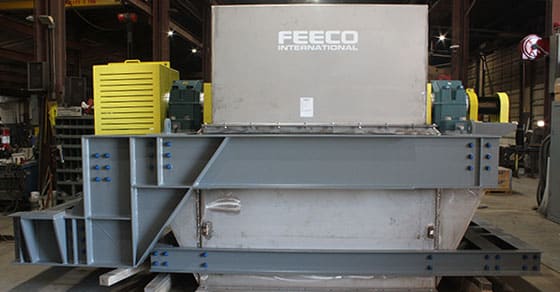Self-supporting bucket elevators, also known as free-standing elevators, offer an essential alternative to large super-capacity bucket elevator designs traditionally supported by structural steel.
In settings which demand several hundred tons per hour of material capacity, such as the potash industry, and where structural steel is not available, the use of FEECO’s self-supporting, large super-capacity design fills a critical gap in the bulk handling equipment market to support these extreme loads.
The following covers how these elevators work and in what situations they offer value, as well as considerations to keep in mind in the selection process.
About Self-Supporting Bucket Elevators
A self-supporting elevator eliminates the need to use external structural steel to support the vertical loading, making this type of elevator ideal for outdoor applications, or those where the existing infrastructure does not permit the incorporation of the otherwise-necessary steel supports.
Self-supporting elevators are available in a wide range of configurations – belt or chain, centrifugal or continuous, etc. – and sizes. While this article is focused on super-capacity elevators, it’s important to note that lower-capacity self-supporting designs are also available.
Non-self-supporting elevators rely on external structural steel to support the bulk of the equipment and material load; bearing pads on the elevator head section are affixed to surrounding structural steel, supporting the head section and leaving the foundation with only the intermediate and boot casings to support. Since the head casing is rigidly mounted to structural steel, an expansion joint is located beneath the head casing to allow for thermal expansion of the intermediate casings.
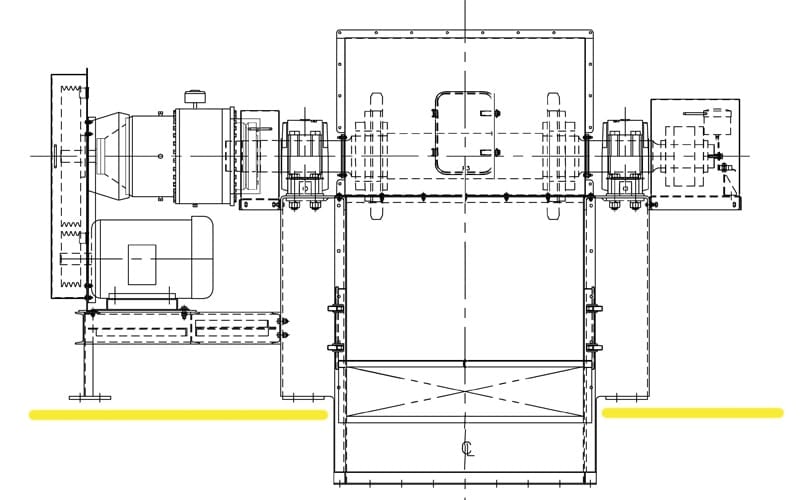
A traditional bucket elevator design relies on the bearings to transfer the weight of the unit into the structural steel floor (indicated in yellow).
In contrast, a self-supporting elevator is completely self-supported, with no need for surrounding structural steel; the casing and foundation bear the entirety of the unit load. The elevator still requires lateral bracing to account for external horizontal loads (wind, seismic, etc.), but the vertical loads are all borne by the casing and foundation.
How Self-Supporting Bucket Elevators Work
At the head section of a self-supporting elevator, a head frame affixed to the bearings transfers the weight of the unit into gusset plates, which in turn transfer the load to the casing (the torque arm is also mounted onto the head frame).
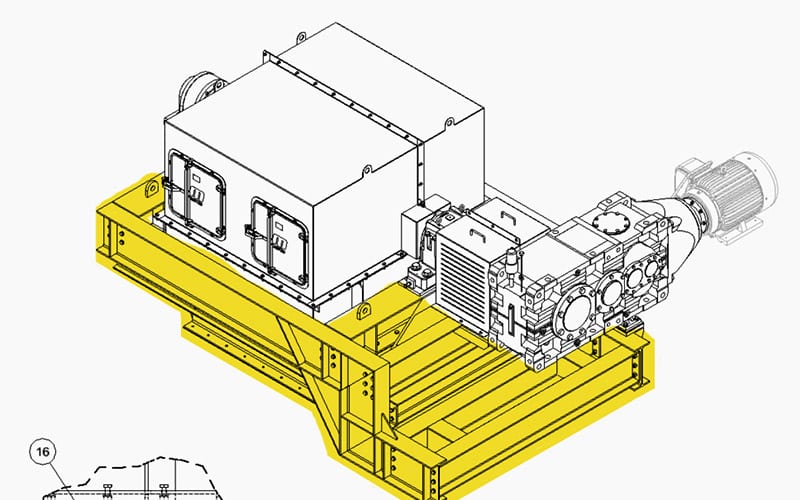
Self-supporting bucket elevators use a head frame, highlighted in yellow, to transfer the load into gusset plates and ultimately, the casing.
Due to the significant load a self-supporting elevator must bear- up to 40,000 lbs of chain pull plus the weight of the casings and drive components- this type of elevator requires a much more robust build compared to non-self-supporting elevators. Each elevator is structurally analyzed by a licensed Professional Engineer to ensure the elevator casing is properly designed to withstand these extreme loads. For example, larger vertical flanges, as shown in the images below, are necessary to assist the casing in supporting the load.
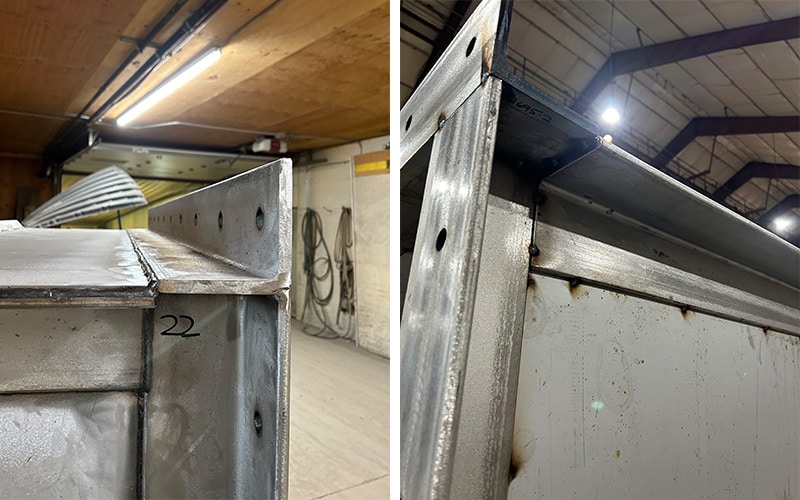
Structural steel angle helps provide support to the casing of a self-supporting elevator
These larger components also mean that self-supporting elevators require a slightly larger footprint, which can be a challenge in replacing existing equipment.
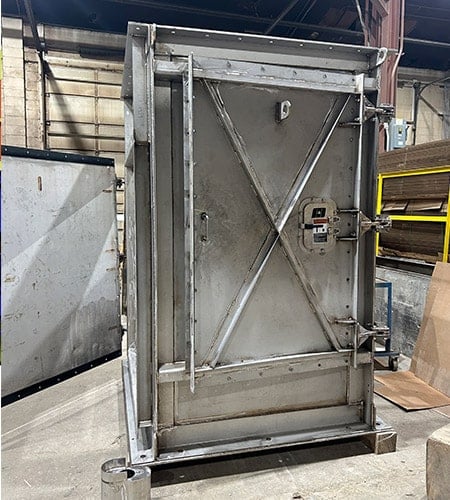
The boot section of a self-supporting elevator features heavy-duty construction, including large doors with heavy-duty hinges and cross member stiffeners.
When to Select a Self-Supporting Bucket Elevator
While many factors may come into play, the choice between a steel-supported bucket elevator and a self-supporting bucket elevator typically comes down to cost, with the cost dependent upon existing (or already required) infrastructure.
Building a New Facility
In comparing only the units themselves, traditional bucket elevators are less costly. However, when the structural steel necessary to support that elevator is factored in, the total cost exceeds that of a self-supporting elevator.
As such, if building a new facility that already requires structural steel to support other process equipment, the traditional elevator offers a more cost-effective option. Were structural steel not needed for other equipment, the self-supporting elevator would be the lower-cost option. A lack of surrounding structural steel also means that elevators to be installed outside are more likely to be better suited to the self-supporting design. It should also be noted that all elevators, regardless of the type, require lateral bracing, though oftentimes they can be braced to existing structures.
Replacing an Existing Elevator
When replacing an existing elevator, the choice depends on whether or not the structural steel needed is already in place, or could be incorporated. If structural steel is already in place, it makes sense to go with the steel-supported option. If structural steel is not present, or if existing steel is not rated to support the load of the elevator, the self-supporting option may be the most cost-effective and practical solution.
Challenges in Replacing an Existing Elevator
Spatial Footprint
Many elevators commissioned in the 70s and 80s were designed to be self-supporting. Now, as those elevators reach the end of their service life, plant managers are looking to replace them. Since these facilities were designed without the structural steel needed to support a traditional-style elevator, plant managers typically stick with the self-supporting design. However, the more heavy-duty build required to meet today’s structural design codes can make this a challenge, requiring a larger spatial footprint than what was originally allotted.
When the new design exceeds the available space, the manufacturer and plant engineers must work collaboratively to find a solution. This might include installing the elevator casings in panelized sections (as opposed to complete casings) that can be more easily maneuvered into place.
Similarly, the installation contractor may also be able to assist in finding a creative solution to fitting the unit, such as bringing it in through a sidewall, instead of from the ceiling.
Foundation Requirements
As part of the elevator replacement process, the manufacturer will provide the expected loads. A revised foundation may be necessary to safely accommodate the load of the unit.
Planning for the Future
Given that a well-built and properly maintained bucket elevator can last for decades, project engineers should also evaluate any potential capacity increases when replacing an existing elevator.
If a capacity increase is potentially in the near future, it may be more cost-effective to incorporate a larger unit now than to replace the newer one down the road.
Finding a Bucket Elevator Manufacturer
When it comes to replacing an existing bucket elevator, plant managers are often faced with the need to find a new OEM; a large portion of the elevators installed in the 70s and 80s were manufactured by a single provider, which no longer services the market.
Due to the complexities often involved in replacing existing equipment, FEECO recommends finding a bucket elevator manufacturer that is not only reputable and willing to work collaboratively, but that will also work to identify the best solution, as well as provide parts and service support after the sale.
Conclusion
Self-supporting super-capacity elevators offer a custom solution to a unique problem, where high-capacity vertical conveying is required but structural steel is not available. When replacing an existing elevator, the ability to work collaboratively with an experienced manufacturer is essential to effectively addressing the many challenges that can arise, from navigating spatial restrictions, to planning for the future.
FEECO has been manufacturing custom, heavy-duty bucket elevators since 1951, offering both traditional and self-supporting designs. For more information on our bucket elevators, or parts and service support, contact us today!

